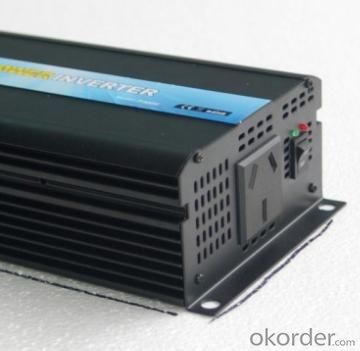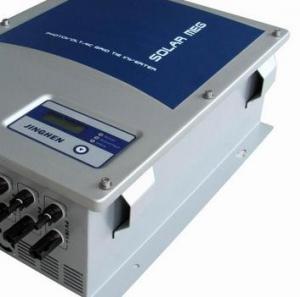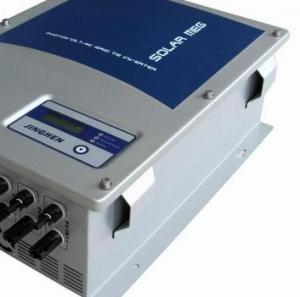Solar High Efficiency Monocrystalline Solar Module very good quality
- Loading Port:
- Shanghai
- Payment Terms:
- TT or LC
- Min Order Qty:
- 2250 watt
- Supply Capability:
- 30000000 watt/month
OKorder Service Pledge
OKorder Financial Service
You Might Also Like
1, Product desciption
Inverter circuits designed to produce a variable output voltage range are often used within motor speed controllers.
The DC power for the inverter section can be derived from a normal AC wall outlet or some other source. Control and feedback circuitry is used to adjust the final output of the inverter section which will ultimately determine the speed of the motor operating under its mechanical load.
Motor speed control needs are numerous and include things like: industrial motor driven equipment, electric vehicles, rail transport systems, and power tools. (See related: variable-frequency drive ) Switching states are developed for positive, negative and zero voltages as per the patterns given in the switching Table.
The generated gate pulses are given to each switch in accordance with the developed pattern and thus the output is obtained.
2, Features of the product
Inverters convert low frequency main AC power to higher frequency for use in induction heating.
To do this, AC power is first rectified to provide DC power. The inverter then changes the DC power to high frequency AC power. Due to the reduction in the number of DC Sources employed, the structure becomes more reliable and the output voltage has higher resolution due to an increase in the number of steps so that the reference sinusoidal voltage can be better achieved.
This configuration has recently become very popular in AC power supply and adjustable speed drive applications. This new inverter can avoid extra clamping diodes or voltage balancing capacitors. There are three kinds of level shifted modulation techniques, namely:
· Built-in 1 year data logger for system analysis
· Charge and discharge status display
· Acoustic load disconnect pre-warning
· Load status indication
· Choose between 5 load disconnect algorithms
· Boost/absorption/float PWM-regulation (series type)
· Integrated temperature compensation
· Covered terminals (up to 16 mm2 wire size)
· Full solid-state protection
Is the electrical grid already nearby or would you need to call in the power company to bring in electrical lines.
If the electric needs to be brought to the area, how much is this going to cost? Depending on how far the grid electric is from the location of the needed lighting, this can be quite expensive.
How much lighting is needed on the street? Do the lights need to be dark sky compliant.
Do the street lights need to run from dusk to dawn or for only a specified number of hours at night.
Are the street lights able to dim in the middle of the night and still provide enough lighting.
These questions need to be answered before you can decide on how many lights you will need to complete the project.
3, Product Image

4, Detailed Specification
INPUT | |
Input voltage range | 185~265±5Vac |
OUTPUT | |
Output voltage range | 185~265±5Vac (AC mode) , 230Vac (DC mode) |
Output frequency (DC mode) | 50Hz (48~54Hz) or 60Hz(58~64Hz), same as AC(AC mode) 50Hz ±0.3Hz (DC mode) |
Wave form | Sine wave (DC Mode) |
Transfer time | 10ms. (Typical) |
BATTERY | |
Rated charging current (max.) | 45A |
Norminal DC input voltage | 12V |
Min. DC start voltage | 20V / 40V |
PHYSICAL | |
Unit dimension (mm) | 526*277*212 |
Master box dimension (mm) | 620*350*370 |
Net weight (1pc, kg) | 22.8 |
- Q:Can solar cells be used in swimming pool heating?
- Yes, solar cells can be used in swimming pool heating. Solar cells, also known as photovoltaic cells, can capture sunlight and convert it into electricity. This electricity can then be used to power heating systems for swimming pools, allowing for a more sustainable and cost-effective way to heat the pool water.
- Q:How do solar cells handle snow or ice accumulation?
- Solar cells are designed to be durable and able to withstand snow or ice accumulation. However, when covered by snow or ice, their energy production is significantly reduced. Some solar panels are designed with a tilted angle and smooth surface, allowing snow to slide off easily. Additionally, the dark color of solar cells helps them absorb sunlight and melt the snow or ice faster. In extreme cases, manual removal of snow or ice may be necessary to restore optimal energy generation.
- Q:What is the impact of solar cells on reducing water usage?
- Solar cells have a positive impact on reducing water usage as they do not require water for their operation, unlike traditional energy sources such as coal or natural gas power plants. By generating electricity from sunlight, solar cells help conserve water resources that would otherwise be used for cooling and steam production in conventional power generation processes. This reduction in water consumption contributes to conserving this precious resource and mitigating the impacts of water scarcity in regions where water availability is limited.
- Q:Are solar cells weather-resistant?
- Yes, solar cells are weather-resistant. They are designed to withstand various weather conditions including rain, snow, wind, and extreme temperatures.
- Q:What is the role of anti-reflective coatings in solar cells?
- The role of anti-reflective coatings in solar cells is to reduce the amount of light reflection from the surface of the cell, thereby increasing the amount of light that can be absorbed and converted into electricity. This helps to enhance the overall efficiency and performance of the solar cell.
- Q:Solar water heater plate can be directly converted into electrical energy?
- Modern solar thermal technology combines sunlight and uses its energy to generate hot water, steam and electricity. In addition to using the right technology to collect solar energy, buildings can also use the sun's light and heat, by adding the appropriate design Equipment, such as a giant south window or the use of building materials that absorb and slowly release the sun's heat.
- Q:Can solar cells be used in telecommunications infrastructure?
- Yes, solar cells can be used in telecommunications infrastructure. They can power various components of the infrastructure such as cell towers, base stations, and remote equipment. Solar cells provide a reliable source of renewable energy that can be harnessed to meet the power requirements of telecommunications systems, particularly in remote and off-grid locations. This helps reduce dependence on traditional grid electricity and lowers the carbon footprint of the infrastructure.
- Q:How do solar cells perform in areas with high levels of air pollution and dust?
- Solar cells do not perform as efficiently in areas with high levels of air pollution and dust. The particles in the air can block sunlight from reaching the solar cells, reducing their ability to generate electricity. Additionally, the dust and pollution can accumulate on the surface of the solar panels, further decreasing their performance. Regular cleaning and maintenance are necessary to ensure optimal efficiency in such areas.
- Q:Can solar cells be used to power remote data collection systems?
- Yes, solar cells can be used to power remote data collection systems. Solar cells convert sunlight into electricity, making them an ideal renewable energy source to power data collection systems in remote areas where access to traditional power sources may be limited or unavailable. The energy harnessed by solar cells can be stored in batteries for continuous power supply, ensuring reliable operation of remote data collection systems.
- Q:Are solar cells durable?
- Yes, solar cells are generally durable. They are designed to withstand harsh weather conditions such as extreme temperatures, rain, and snow. Additionally, most solar cells come with a warranty that guarantees their performance for a certain period, indicating their durability. However, like any technology, the lifespan of solar cells can vary depending on the quality of the materials used and how well they are maintained.
1. Manufacturer Overview |
|
|---|---|
| Location | |
| Year Established | |
| Annual Output Value | |
| Main Markets | |
| Company Certifications | |
2. Manufacturer Certificates |
|
|---|---|
| a) Certification Name | |
| Range | |
| Reference | |
| Validity Period | |
3. Manufacturer Capability |
|
|---|---|
| a)Trade Capacity | |
| Nearest Port | |
| Export Percentage | |
| No.of Employees in Trade Department | |
| Language Spoken: | |
| b)Factory Information | |
| Factory Size: | |
| No. of Production Lines | |
| Contract Manufacturing | |
| Product Price Range | |
Send your message to us
Solar High Efficiency Monocrystalline Solar Module very good quality
- Loading Port:
- Shanghai
- Payment Terms:
- TT or LC
- Min Order Qty:
- 2250 watt
- Supply Capability:
- 30000000 watt/month
OKorder Service Pledge
OKorder Financial Service
Similar products
New products
Hot products
Related keywords





























